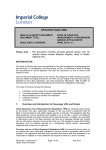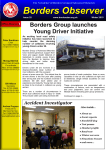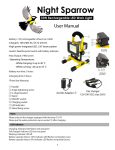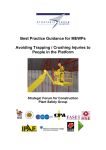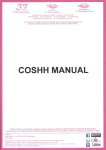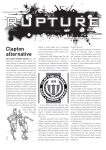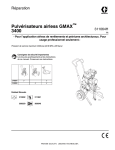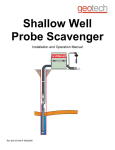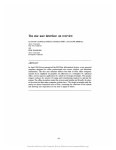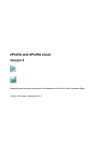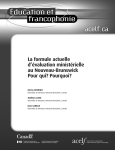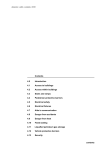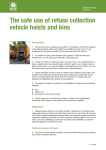Download Background Paper PDF 1 MB - Meetings, agendas, and minutes
Transcript
MERTHYR TYDFIL COUNTY BOROUGH COUNCIL FULL COUNCIL MEETING 5.30 PM WEDNESDAY, 6TH NOVEMBER, 2013 The attached reports have been added as Background Papers to the previously published Agenda for the above mentioned Committee. Anyone requiring information should contact the Democratic Services Department on (01685) 725203 or [email protected] 21. Equality Peer Review Report To consider a report of the Chief Executive. 22. Minibus Policy To consider a report of the Chief Executive. 23. (Pages 1 - 34) (Pages 35 - 60) Provision and use of Work Equipment Policy To consider a report of the Chief Executive. (Pages 61 - 80) This page is intentionally left blank Agenda Item 21 Equality Improvement Peer Review Merthyr Tydfil County Borough Council Report 20/21 June 2013 1 Page 1 Contact Welsh Local Government Association The WLGA’s primary purposes are to promote a better local government, its reputation and to support authorities in the development of policies and priorities which will improve public service and democracy. It represents the 22 local authorities in Wales, with the 3 fire and rescue authorities and 3 national park authorities as associate members. Welsh Local Government Association Local Government House Drake Walk Cardiff CF10 4LG Tel: 029 2046 8600 Fax: 029 2046 8601 www.wlga.gov.uk 2 Page 2 Background This report is a summary of the findings of the equality improvement peer review undertaken for Merthyr Tydfil County Borough Council (CBC) in June 2013, which was organised by the Welsh Local Government Association (WLGA) and carried out by its peers. A peer review is designed to validate an authority’s own self assessment by considering documentary evidence and carrying out a series of interviews and focus groups with Elected Members, staff and other stakeholders. Importantly, a peer review is not an inspection; rather it offers an external assessment of an authority’s own judgement of its performance. Peer assessors are critical friends who have experience of delivering on the particular agenda in their own organisations. Their role is to identify areas of strength and areas of improvement. A peer review is… A peer review is not… • An objective external perspective • An audit or inspection provided by critical friends • Aimed at identifying both areas • A detailed check of strength and improvement against compliance • A ‘snapshot’ based on evidence • An indepth analysis of provided and the interviews all processes and undertaken practices • A process - WLGA will continue • An event to work with the authority following the final report, if required Methodology The basis for the equality peer review is the Equality Improvement Framework (EIF) for Wales, which can be viewed here: http://www.wlga.gov.uk/english/equality-improvement-frameworkfor-wales/. 3 Page 3 There are four areas of the Framework: • Community Engagement • Leadership and Organisational Commitment • Generating Outcomes • Equipped Workforce This peer review was therefore based on an examination of processes, policies, performance and outcomes associated with each of these areas, which are the building blocks of equality improvement. The review consisted of two parts. Firstly, the peers conducted a desktop analysis of the completed WLGA self assessment framework (attached as Appendix A), a narrative report and supporting documents provided by Merthyr Tydfil CBC. Secondly, the peers undertook a two day site visit which involved a series of interviews and group meetings with Members, staff and stakeholders to gain more detailed insight. Based on the peer team’s analysis, initial findings including observations and recommendations, were presented to Merthyr Tydfil CBC at the end of the site visit. This report provides further analysis against the areas of the EIF. Peers for this review were: Anna Morgan – Equalities Training Advisor, Welsh Local Government Association Bernadette Elias – Head of Policy Performance & Development, Blaenau Gwent County Borough Council Catryn Holzinger - Policy and Improvement Advisor, Welsh Local Government Association David Thomas – Senior Policy Officer (Equalities and Welsh Language), Caerphilly County Borough Council Rob Beardall – Equalities Officer, Powys County Council The WLGA would like to take this opportunity to thank Merthyr Tydfil CBC for inviting the WLGA to undertake the equality improvement peer review, particularly at a time when local authorities are facing significant challenges in the form of reduced budgets, increasing demand for services and multiple, competing priorities. The peer team appreciated the welcome and hospitality provided by the authority and would like to thank everybody they met during the process for their time and contributions 4 Page 4 Detailed Findings 1 Community Engagement Strengths 1.1 There are a number of examples of notable practice in community engagement. These include permanent mechanisms, such as the established Older People’s Forum and the Youth Forum which have strong ties to the council and are able to inform and influence decision-making. They also include engagement and consultation on specific issues, such as the development of the contact centre and residential care. Furthermore, tailored techniques have been developed, such as the Multiple Intervention Assistance (MIA) Children and Young people engagement tool. 1.2 Crucially, these examples have provided or continue to provide a genuine means for the community to influence council policy and delivery. For example, extensive consultation was undertaken in relation to the contact centre, the result of which was a service designed to meet citizen need. Another example is the Youth Mayor, whereby each successive Mayor makes a ‘pledge’ and is given direct access to relevant departments to help them deliver on it. 1.3 Merthyr’s approach to Communities First is progressive, with the council taking on a more facilitational role and the design and delivery being taking forward by the cluster managers and communities. This is reflective of a ‘coproductive’ ethos. 1.4 The detailed work undertaken on the ‘Community Conversation’ as part of the development of the Community Cohesion Strategy provides a rich source of information on how people feel about their communities and the services they receive. 1.5 The Equality and Older People’s Elected Member Champions are valuable assets to the council, having strong links to disadvantaged communities. 5 Page 5 1.6 The Equality Champion, Equality Officer and Community Cohesion Officers have also made substantial efforts to engage with new communities in Merthyr Tydfil and there is a Migrant Workers Forum. 1.7 The procurement team engages and works closely with SMEs with the aim of supporting local business. 1.8 A consultation exercise was undertaken for the last budget, including four roadshows and an online web survey. The learning from this exercise has resulted in the decision to carry out the next exercise earlier, engaging with the communications staff and Contact magazine, with a view to increasing the response rate. 1.9 The peer review self assessment and interviews highlighted that the council has been evaluating and is seeking to build upon its existing approach to consultation and engagement. Measures to strengthen the approach are currently at various stages of development and implementation, such as the Community Voice programme and the LSBs engagement and consultation work, which includes the Citizens’ Panel and consultation and engagement hub. Areas for Improvement 1.10 While there are some extremely positive examples of active community engagement, this could be strengthened by bringing the range of activity together in a more corporate and strategic manner. This would provide a number of benefits, including; • Improving the sharing of information • Reducing any duplication • Making good use of time and resources • Ensuring there are consistently high standards across engagement and consultation activity. It is recognised that the Local Service Board (LSB) engagement and consultation work will seek to achieve this, though it is worth emphasising that equality and engaging with people with protected characteristics should be an overt consideration as part of these developments. Engagement is 6 Page 6 not only a key means of improving services but also a statutory responsibility in relation to equality, as set out under the specific duties for Wales. 1.11 It was also noted that the protected characteristic groups with well-established fora, such as older people, children and young people and disabled people, play a strong part in planning and have good access into the organisation. However, this level of engagement could be replicated with other protected characteristic groups to ensure they have the same opportunities to influence decision-making. Merthyr’s portfolio of Community Voice projects, MAGNET (Merthyr Achieving Greater Networking and Engagement Together), will be an important means of achieving this. 1.12 The role of the Elected Member Champions could be developed further, recognising they are a point of contact for communities, officers and Members alike. They have a valuable role to play in engaging stakeholders and supporting equality improvement in general. Please see point 2.3. 1.13 Some staff noted good operational sharing of data, but room for improvement in terms of coordinating and using data, and specifically equality data, more strategically. The collection of equality data for the Strategic Equality Plan (SEP) and needs assessment data for the Single Integrated Plan (SIP) could also be joined-up in future, recognising that both require data gathering and there is an overlap in the data required for each. Furthermore, joining-up the intelligence would support the alignment of the two documents. Proposals for Improvement 1.14 The authority should ensure a continued focus on protected characteristic groups throughout the development of engagement and consultation work. This report recognises the council is already undertaking work to extend and strengthen its approach to engagement and consultation, but would emphasise the importance of 7 Page 7 ensuring a continuing focus across the protected characteristics as part of this. For example, it will be important to ensure the Citizens’ Panel is representative and that additional engagement with protected characteristic groups is undertaken where necessary to ensure there is sufficient representation of each. 1.15 The authority could share effective practice and develop consistent standards for engagement and consultation. The LSB engagement and consultation work will seek to share effective practice and develop consistent standards (both across partners in Merthyr Tydfil and Rhondda Cynon Taf LSBs). This could include extending the use of tools that support engagement with protected characteristics groups, such as the MIA engagement tool or encouraging other departments and partners to engage with fora, such as the Youth Forum. It could also involve developing common principles on when to engage and to what level, as appropriate to the situation or issue, with the aim of supporting professionals in effectively engaging with protected characteristic and seldom heard groups. 1.16 The authority should develop an effective process for the coordination, collection and use of equality data from service delivery, the census and other sources to shape equality objectives within the SEP and business planning process. This will help ensure the council has an effective process for setting equality objectives (as per above), highlighting how equality work can help serve the community, target resources effectively and deliver better outcomes. Including Welsh language data within this could help integrate the two areas of work. 1.17 The authority could align and coordinate the collection of equality information and ongoing partnership needs assessment work undertaken for the SEP and SIP. Aligning the two could reduce duplication of effort and increase the line of sight between the two strategies. 8 Page 8 1.18 The authority could support community and protected characteristic groups within the procurement process. While the procurement team work closely with local SMEs, they could consider how support could be targeted towards community groups and organisations established by or for protected characteristic groups. 9 Page 9 2 Leadership and Organisational Commitment Strengths 2.1 A clear commitment to equality was articulated by both the political and professional leadership. 2.2 The majority of political and professional leaders and operational officers identified the equality officer as the lead person on equality in the organisation, noting her energy and drive as key factors in taking the agenda forward. 2.3 Both the Equality and Older Person’s Elected Member Champions were recognised as powerful advocates, with strong links to communities and an evident personal commitment to their causes. The Champions are, therefore, viewed as valuable assets to the organisation. 2.4 Steps have been taken by the political and professional leadership to help embed equality in council business, such as including equality implications on council and cabinet reports, including it as a standing item on scrutiny agendas and inviting the equality officer to attend monthly senior management business meetings. Some felt that these measures had helped to bring about a change in culture on equality. 2.5 It was noted that there are close working relationships in the organisation and some feel that senior officers are approachable and accessible. This has the potential to support equality work by making it easier to work together, change culture and deliver improvement. Areas for Improvement 2.6 Though there is evident commitment at the top of the organisation, lines of accountability are less clear. Often the equality officer is seen as the person who is responsible for ‘enforcing’ equality work or accountable for its delivery. Equality improvement would benefit from senior commitment Page1010 translating into clearer direction, ownership and accountability. 2.7 While some felt that measures to keep equality on the agenda were beginning to change culture, others disputed their value, suggesting they might function more as a ‘tickbox’ exercise in practice. 2.8 While the SEP is the council’s key strategic document for equality, it wasn’t always understood to be integral to organisational business. Evidence from some interviews showed that it wasn’t always clear where officers saw the SEP in relation to their service areas or individual areas of responsibility. Furthermore, it wasn’t apparent how equality objectives drove and influenced service objectives. The next phase of developing the SEP and embedding equality work could focus on strengthening the ‘line of sight’ between the council’s vision for equality and organisational business. 2.9 A stronger strategic direction in relation to equality would also support the Equality Elected Member Champion’s role. Currently, the Champion supports the equality officer in overcoming barriers as and when they arise but a clearer strategic direction would enable the Champion to be more proactive in generating change. 2.10 While there was evident commitment from the political leadership and Elected Member Champions, the council could increase the involvement and awareness of other councillors. All councillors have a responsibility for equality in their various roles, including representing people in their wards and ensuring equality is considered as part of scrutiny. 2.11 Though equality, and specifically equality impact assessment (EIA), has been included in agendas this could be further developed to ensure there is effective challenge. For example, it was noted that there has only been one occasion where a challenge was made at a budget meeting on the basis of an EIA. Increasing Members’ knowledge of equality issues and the EIA process would enable them to provide challenge as and when necessary. 11 Page 11 Proposals for Improvement 2.12 The professional leadership should increase their ownership of equality work and consider how they use corporate processes to improve accountability for it. In practice this could mean ensuring equality is effectively embedded in business planning, self evaluation and risk management processes and that the SEP is, and is seen to be, the driver of equality work. This is described in more detail in section 3. 2.13 The authority could further utilise the Equality and Older People’s Elected Member Champions. While they have strong links to the community and are a force for driving change forward, there is greater scope to align their efforts to the equality objectives and priorities for improvement. Planning how they can use their unique position to further these objectives would enable them to have maximum impact. 2.14 Equality training should be developed further, including a specific focus for Members. This could draw on a variety of methods, including less traditional training, such as visiting other areas or particular projects. This could also focus on some of the less wellestablished issues and protected characteristics. Training for Elected Members and close political scrutiny are already included as priorities in the Community Cohesion Action Plan and this report reiterates the value of moving forward with this. 2.15 Aspects of equality could be built into the development of the scrutiny forward work programmes more robustly. There are further opportunities for equality to be built into scrutiny’s forward work programme and to provide additional support and training to scrutiny committee members. This would maximise the value of having equality included as a standing item on scrutiny agendas. Page1212 2.16 The authority could consider re-establishing the Corporate Equality Working Group (CEWG). While the Equality Officer is invited to attend monthly senior management business meetings, the CEWG no longer meets. Some authorities have found these groups to be useful in overseeing the implementation of overall equality work in the organisation and developing new policy and practice, such as an EIA process. The organisation may wish to consider reforming this group with appropriate membership and terms of reference. 13 Page 13 3 Generating Outcomes Strengths 3.1 The peer review team noted a common commitment to delivering the best possible outcomes for the people of Merthyr. This clear dedication and sense of working together for a common purpose came across in many of the interviews. 3.2 There are strong operational links between the equality officer and other key delivery areas, most notably Community Cohesion. These two areas have built close, productive links. 3.3 The equality officer also has a close working relationship with the Elected Member Equality Champion, providing a real opportunity to overcome obstacles to operational changes that can help generate outcomes. There is a similar close working relationship between the Older People’s Elected Member Champion and the Older People’s Coordinator. 3.4 Many services demonstrate a citizen-focused, coproductive ethos whereby provision is tailored to the needs of citizens or directed by the community. This was evident in several interviews and particularly so in MIA, Community Cohesion and Communities First. 3.5 Some, mainly senior officers, interviewed, felt that the equality processes that had been introduced were helping to shift mindsets, changing conversations from ‘has that been done?’ to ‘what is the impact?’. 3.6 Schools in the Borough have produced SEPs and annual reports on progress have been prepared. The local authority provided information, support and guidance and schools used that information to develop their own objectives. SEPs were said to have helped to reinforce and formalise existing work on equality and develop consistency across schools. Page1414 3.7 The authority has developed productive collaborative links with neighbouring authorities to increase its capacity, which in turn has had positive benefits for equality improvement. Examples include procurement (working with consortium) and the LSB’s engagement and consultation work (working with Rhondda Cynon Taf). It was noted that regional working has helped the authority achieve further outcomes at greater pace. Areas for Improvement 3.8 The SEP does not appear to be the driver for equality work in the organisation. The SEP equality objectives could be better positioned and more integral to service planning, improvement and partnership working. Whilst the equality objectives are situated within service area business plans, it is not evident the SEP has generated new work on equality issues. 3.9 On balance, equality improvement is more associated with compliance with legislation, rather than generating outcomes. The authority has undertaken work to meet the requirements of the specific duties for Wales but the added value of delivering service improvement, mitigating risk and generating meaningful outcomes did not appear to be at the forefront of equality thinking in the organisation. The next stage in the development of the council’s equality work is making the shift from processes and compliance to using equality work to help the organisation achieve outcomes. The council could reframe equality work in terms of ‘serving the community better’, communicating this to staff and helping them to understand how it can help them in their roles. 3.10 Contrary to the view held by some that EIAs were helping to change culture and reframe conversations, many officers felt they were still seen as a ‘tickbox exercise’, being completed to meet legal requirements rather than because they can add real value to service planning and decision-making. This reflects the general emphasis on compliance, rather than added value. Lack of knowledge in terms of their value, 15 Page 15 purpose and how to undertake them were identified as reasons EIAs had not developed into a useful tool. 3.11 Some officers alluded to ‘death by impact assessment’ as there are multiple impact assessments, including the Single Integrated Plan and Sustainability Impact Assessment. 3.12 While EIAs were regarded as useful in supporting budget setting, the responsibility for undertaking them rests with service areas. Given the points above, an improved corporate EIA process with increased buy-in across the organisation would be beneficial to the budget-setting process. 3.13 Links between the SEP and SIP could be strengthened. The SIP includes a reference to equality as a cross-cutting theme but it is not clear how equality has been embedded in the strategy and wider partnership activity. The SIP and SEP could articulate how one relates to the other and how these are mutually reinforcing areas of work. Some suggested there is also the opportunity to strengthen links between strategic partnership working and key areas including Community Cohesion and Communities First. 3.14 As previously outlined in relation to community engagement, many officers felt there was a stronger emphasis on certain protected characteristic groups and therefore the equality agenda in the authority primarily centres on disability, older people and Gypsies and Travellers. 3.15 The council does not currently have an up-to-date approved Welsh Language Scheme (WLS) in place. The reasons for this are understood, however without identified actions it is difficult to take the agenda forward. Proposals for Improvement 3.16 The SEP should be used to drive equality work within the business planning process. Equality objectives should be set with services areas on the basis of engagement with stakeholders and analysis of equality information. This will Page1616 ensure the organisation is effectively responding to the needs of protected characteristic groups, with the SEP as the main driver and the objectives embedded in organisational business. This is a medium-term goal which is reliant on supporting processes, such as the collection and analysis of equality data and engagement and consultation across the protected characteristics working well. The formulation and review of objectives must be responsive and dynamic and it is good practice for equality objectives to be reviewed regularly over the course of the plan, in light of new information, to ensure they are genuinely representative of local need. Equality and Human Rights Commission (EHRC) guidance on equality objectives emphasises the importance of intelligence; ‘To achieve the aims of the duty, the objectives need to focus on the most significant equality issues and be sufficiently wide in scope. In order to meet the duty, the objectives must be based on adequate information and proper engagement.’1 3.17 Equality should be embedded in strategic partnership working and links between the SEP and SIP could be strengthened. In practice this could mean joining up the collection of equality data with the needs assessment (see point 1.17), impact assessing partnership projects (in addition to the high level SIP document) and embedding equality in partnership scrutiny, as well as articulating how the SIP and SEP relate to one another and how these are mutually reinforcing areas of work. 3.18 The EIA process should be reviewed, in consultation with staff in key service areas to ensure understanding and buy-in to the process. Any revised process could be accompanied by guidance on when they should be undertaken and to what level, with the aim of developing a proportionate and sustainable approach that is owned by the 1 EHRC, Equality Objectives and Strategic Equality Plans: A guide for listed public authorities in Wales, 2011 17 Page 17 relevant individuals and not reliant on involvement from the equality officer. 3.19 Awareness and expertise should be developed in relation to EIAs to increase challenge and improve their quality. This could be achieved through training of Members, staff and union representatives. There is a duty to publish all EIAs that have a ‘substantial impact’ but the authority could choose to publish all EIAs or make them available internally so there is transparency and staff can see how they are done. As part of this awareness raising, the benefits of EIA should be promoted, with the aim of increasing buy-in, which should in turn increase the use and quality of EIAs. 3.20 The authority could consider how its EIA process could be integrated within and complement other corporate processes, including self evaluation and business planning, risk management, project management and also how the various impact assessments could be brought into a more streamlined process. 3.21 It would be beneficial to develop ‘quality assurance’ for EIAs, particularly for those where there may be a substantial impact. This could be provided internally by other service areas, by third sector partners or a Corporate Equality Working Group, if one were to be re-established. This would help drive sustained quality by providing officers with useful feedback. 3.22 The authority should consider how it builds the equality dimension into current priority areas of work, such as welfare reform. For example, work is already underway in relation to welfare reform, with further developments, such as the Communities First and Citizens’ Advice Bureau Financial Inclusion Forum, planned. Evidence shows that there is a specific equality dimension to welfare reform and the authority’s approach should analyse the impact on protected characteristic groups to help understand need and develop appropriate responses. Page1818 3.23 The authority should consider updating the WLS or developing some interim priority actions ahead of the introduction of the new standards. This is in recognition of statutory requirements, as well as an opportunity to progress the agenda. Furthermore, the authority may wish to consider these alongside the actions in the SEP to avoid duplication and achieve quick results, given there are many overlapping requirements between the SEP and the WLS. 19 Page 19 4 Equipped Workforce Strengths 4.1 Human Resources (HR) policies are regularly reviewed and updated. Consequently many older policies have been brought together and simplified and have equality considerations built into them. However, there may be some policies that were last updated prior to the duty to impact assess coming into force. 4.2 There are examples of where equality training needs have been identified and met. For example, Community Cohesion officers have provided equality training to frontline staff and social care explore training needs then work with the equality officer to deliver an appropriate programme. 4.3 The authority has developed an arrangement with school governing bodies whereby the cost of their Service Level Agreement (SLA) is reduced if they sign up to a training programme, with the aim of equipping governors with the knowledge they need to help them undertake their role. 4.4 Strong collaborative links with neighbouring authorities has helped to build capacity in the workforce in areas such as procurement. 4.5 The authority’s redeployment scheme was identified as a good example of taking individual needs into account and responding to them accordingly. 4.6 Staff at all levels seem to have a good understanding of local issues (though not necessarily all equality issues) and are committed to delivering for people in Merthyr. 4.7 The Civic Centre building is regarded as improving in terms of access and front facing staff understand the needs of service users. 4.8 Equalities has been considered as part of the corporate branding and corporate style guide, which provides a Page2020 checklist for minimum standards to ensure the needs of people with protected characteristics are considered and there is consistency in communication. Areas for Improvement 4.9 Some felt that the ongoing requirements of the new duties in relation to employment were not fully recognised and that Job Evaluation was seen as a ‘one-off exercise’. For example, Payroll and HR systems are not integrated which means that equality employment information (required to be collected under the specific duties) can only be compiled by combining a number of data bases, meaning the process is labour intensive rather than automatic. There was also concern that the data might not cover the full range of protected characteristics, meaning the authority would not be able to fully meet its statutory duty to collect and publish the complete range of employment information. 4.10 The corporate approach to equality training could be strengthened. Listed bodies in Wales have a duty to promote knowledge and understanding of the general and specific equality duties among their employees and equality training is an important means of achieving equality improvement. Equality training could come in the form of awareness raising for staff and members, it could be specific to an area of work, such as procurement or it could relate to a process, such as EIA. There are examples of where training has been developed and there are skills and experience within the organisation that could be utilised as part of a corporate approach to equality training. Raising awareness of equality among staff is a ‘must do’. 4.11 Furthermore, the need for equality training was identified several times. For example, it was not clear how Members’ equality training requirements were being met. In terms of staff, it was felt that there might be less understanding of issues relating to certain protected characteristics and that general awareness of equality issues is low. It was also noted that awareness in ‘satellite’ centres may be lower than in the Civic Centre. 21 Page 21 4.12 As highlighted throughout this report, there are a number of examples of good practice in relation to equality. The organisation could improve the sharing of these practices and experiences. This could be built into internal training, shared through developing mechanisms such as the engagement and consultation work, senior management business meetings or a Corporate Equality Working Group. This would not only help extend the use of best practice across the organisation but would also promote the added value of equality work to staff. 4.13 There is a strong culture of ‘meeting community need’ and generating outcomes in the organisation. Currently equality is not seen as part of that picture and is less favourably associated with process. However, the team noted a very high level of commitment to making a difference to people in Methyr Tydfil, which represents a real opportunity to reposition equality as a means of achieving better outcomes, which could generate enthusiasm for the agenda and help officers see how an equality perspective can support their work. See section 3 for further details. 4.14 Some felt there was a culture of complacency around equality improvement, which could result in resistance and tension when new equality work is being driven forward. 4.15 Equality objectives and expectations around equality competencies are not linked to individual performance reviews, meaning there is not a ‘golden thread’ from vision to individual action and behaviour. 4.16 Currently, responsibility for carrying out equality work rests with a small number of staff. Extending this responsibility and mainstreaming equality should be the long term goal. 4.17 It was acknowledged that there has been little progress on establishing staff networks to engage with protected characteristic groups. The reason for this is the time and resource required to set them up, but supporting them on an ongoing basis also involves a time commitment. Page2222 4.18 Some felt that the overall culture of the organisation was confrontational and there isn’t currently a strategy for developing a different organisational culture. Proposals for Improvement 4.19 The authority could review HR policies and processes to ensure they are up-to-date and reflect new legislation, including HR policies (which may not have been impact assessed), training and awareness raising (see below) and the collection of employment information. It is a legal requirement that these policies and processes are compliant with the specific duties in Wales. 4.20 The authority could develop a more corporate approach to equality training, taking a longer term strategic view of the training needs of members and staff across the organisation by, for example, undertaking a whole-authority training needs analysis, and allocating training budgets accordingly. This could build on the existing courses, as well as the knowledge, skills and experience of Elected Member Champions, staff, partners and the WLGA, to develop both traditional and less formal forms of training such as sharing practice and e-learning. It could use case studies to highlight the consequences of non-compliance, but should also have a significant focus on highlighting the additional benefits equality can bring to services so that staff can see how it can help them in their role. Training represents a valuable opportunity to reposition equality in terms of ‘serving the community better’, as outlined in point 3.9. 4.21 The authority could strengthen the link between individual action and behaviours and equality work. This could be achieved through the performance review process and could be built into a competency framework. 4.22 The authority could consider establishing a staff network/s as a means of engaging protected characteristic 23 Page 23 groups of employees. The configurations of the network should be realistic, reflecting available resources. 4.23 The authority could consider how the equality function has maximum influence across the organisation. Equality work has stronger links with some areas than others and there is a need to further embed it in service delivery across the organisation as part of the shift from ‘compliance’ to ‘generating outcomes’. As part of this the authority may wish to consider where the equality function could have the most impact and influence, depending on its priorities for equality improvement. Page2424 5. Key findings The following points were recurrent themes that cut across many areas already identified in this report. These represent the team’s key strategic findings. 5.1 Evidence throughout this report suggests the approach to equality is largely shaped by external legal drivers, and this was acknowledged within the organisation. The authority has undertaken work to ensure it is meeting the requirements of the specific duties for Wales but equality work is less often seen as a means of making a difference and improving outcomes for people in Merthyr. Reframing equality in the context of ‘serving the community better’ would improve the reputation of the equality agenda and help staff understand how it fits with and supports their work. While there are inevitable financial constraints and competing priorities, it is important to emphasise that equality work is a statutory ‘must do’. Given this, it is necessary to maximise its potential by using equality processes as a means of adding value to priority areas of work. 5.2 The political and professional leadership articulated their commitment to equality. Furthermore, a commitment to delivering the best possible outcomes for the people of Merthyr was a common theme across all of the interviews. However, the overall direction of equality work and the lines of accountability are less clear. Equality improvement would benefit from demonstrable senior commitment translating into clearer direction and accountability. 5.3 The team identified many examples of good equality practice and these are highlighted throughout the report. However, there are opportunities to develop more corporate approaches which would help share and extend the use of good practice. Examples include training, engagement and consultation. 5.4 Whilst this report has warned against an over-reliance on process it is also important to remember that the processes outlined in the specific duties for Wales are statutory and 25 Page 25 they also have the potential to embed sustainable equality practices. Over the longer-term, the authority should aim to use the statutory processes to mainstream the agenda and extend responsibility beyond the small number of staff currently identified as taking equality work forward. Taking a proportional approach that ‘fits’ with the authority’s culture, structure and corporate processes will support this. 5.5 While the Equality Officer is responsible for both equality and Welsh language issues, the impression gained during the review was that though these are seen as related, they are in practice regarded as distinct agendas and the benefits of greater integration between the two are not fully appreciated. Furthermore, it was felt that Welsh language is given less credence than equality, though conversely some regarded Welsh language issues as having too great an emphasis in terms of resource, and in general there are lower levels of awareness of Welsh language issues and the legislative and policy context (see point 3.24 for related proposal for improvement). Page2626 6. Proposals for Improvement The section below is a compilation of the proposals for improvement identified throughout this report. It is not listed in terms of priority, rather it is divided into three phases, which set out the shorter term changes (phase 1), leading to longer term changes (phase 3). Phase 1 – Shorter term 6.1 The authority should ensure a continued focus on protected characteristic groups throughout the development of consultation and engagement work. 6.2 The authority could share effective practice and develop consistent standards for consultation and engagement. 6.3 Equality training should be developed further, including a specific focus for Members. 6.4 The authority could consider re-establishing the Corporate Equality Working Group (CEWG). More information on establishing effective corporate working groups can be found in WLGA advice note, published April 2010 http://www.wlga.gov.uk/equalities-publications/deliveringequality-outcomes-establishing-and-maintaining-effectivecorporate-working-groups/ 6.5 The EIA process should be reviewed. 6.6 Awareness and expertise should be developed in relation to EIAs to increase challenge and improve their quality. 6.7 The authority could consider how its EIA process could be integrated within and complement other corporate processes. 6.8 The authority should consider how it builds the equality dimension into current priority areas of work, such as welfare reform. 27 27 Page 6.9 The authority should consider updating the WLS or developing some interim priority actions ahead of the introduction of the new standards. Phase 2 – Medium term 6.10 The authority should develop an effective process for the coordination, collection and use of equality data from service delivery, the census and other sources to shape equality objectives within the SEP and business planning process. 6.11 The authority could align and coordinate the collection of equality information and ongoing partnership needs assessment work undertaken for the SEP and SIP. 6.12 The authority could further utilise the Equality and Older People’s Member Champions. 6.13 The authority could support community and protected characteristic groups within the procurement process. More information on embedding equality in the procurement process can be found in WLGA advice note, published May 2013 http://www.wlga.gov.uk/publicationsequalities/building-equality-considerations-into-thecommissioning-and-procurement-process. 6.14 The professional leadership should increase their ownership of equality work and consider how they use corporate processes to improve accountability for it. 6.15 Aspects of equality could be built into the development of the scrutiny forward work programmes more robustly. 6.16 It would be beneficial to develop ‘quality assurance’ for EIAs. 6.17 The authority should review HR policies and processes to ensure they are up-to-date and reflect new legislation. 6.18 The authority could consider establishing a staff network/s. 2828 Page Phase 3 – Long term 6.19 The SEP should be used to drive equality work within the business planning process. 6.20 Equality should be embedded in strategic partnership working and links between the SEP and SIP could be strengthened. More information on embedding equality in integrated planning can be found in WLGA advice note, published May 2013 http://www.wlga.gov.uk/publicationsequalities/equality-and-integrated-planning-l-an-advice-notefor-local-authorities-in-wales. 6.21 The authority should develop a more corporate approach to equality training, taking a strategic view of the training needs of members and staff across the organisation by, for example, undertaking a whole-authority training needs analysis, and aligning training budgets accordingly. 6.22 The authority could strengthen the link between individual action and behaviours and equality work. 6.23 The authority could consider how the equality function has maximum influence across the organisation. 29 29 Page Appendix 1 Page 30 Community Engagement 1 Strengths 1.1 Streamlined gathering of data and evidence: The authority is in a position to identify and understand robust data and evidence on issues of localised inequality 1.2 Consulting and involving the right people on the right things: The authority consults and involves relevant groups within the community and individuals on equality objectives, equality impact assessments, significant policy and service delivery plans 1.3 Transparency and accountability on equality commitments and improvement progress: The authority keeps the local community well informed and provides opportunities for challenge against equality commitments and progress 1.4 Fostering good relations, community cohesion and sustainability: The organisation is assisting in relationship building and improving community cohesion within and between local communities 30 1.4 2 Areas for Improvement 1.13 3 Proposals for Improvement 1.16, 1.17 1.1, 1.4, 1.8 1.11 1.14, 1.18 1.1 1.10 1.14, 1.15 1.4, 1.6, 3.2 3.13 Page 31 Leadership and Organisational Commitment 1 Strengths 2.1 2 Areas for Improvement 2.6 3 Proposals for Improvement 2.12 2.1 Leadership vision and principles: The leadership of the organisation have publicly stated what the organisation wants to achieve and the key priorities in relation to equality 2.2 Leadership support, commitment and challenge: The leadership of the organisation provide ongoing support, commitment and challenge to generate the necessary organisational buy-in for the agenda 2.3 Management accountability: Corporate vision and principles and equality objectives are becoming real through clearly evidenced commitments at the management level 2.4 Collaborative partnership working: The authority has agreed with partners that the equality improvement work is to be conducted in collaboration and partnership 2.5 Improving participation of under-represented groups: The organisation provides opportunities and the means by which marginalised and under-represented people of the local community can participate more in public life 2.4 2.6, 2.10, 2.11 2.12, 2.13, 2.14, 2.15 2.6 2.12 3.7, 4.4 3.13 1.17, 3.17 1.2 1.11 1.14 31 Generating Outcomes 1 Strengths Page 32 3.1 Setting equality objectives: Corporate equality objectives and an associated strategic equality plan have been agreed by the organisation 3.2 Managing and reporting progress: There is an equality management mechanism in place that will enable corporate vision and principles and equality objectives to happen 3.3 Assessing and monitoring impact: The organisation has an effective corporate process established to enable the ongoing assessment of impact across services 3.4 Business planning process: The necessary mechanisms have been established to enable equality improvement to happen through the business planning process 3.5 Procurement practice: The organisation has procedures and practices in place that will enable the procured services to meet the organisation’s commitment and expectations on equality 3.6 Connecting cross-cutting agendas: Links have been made with other cross-cutting agendas to enable a joined-up approach to generating improved outcomes for the local community 32 3.5 2 Areas for Improvement 2.8, 3.8 3 Proposals for Improvement 3.16 2.8, 3.8 2.15, 2.16, 3.16 3.10, 3.11, 3.12 3.18, 3.19, 3.20, 3.21 2.8, 3.8 3.16 1.7, 3.7, 4.4 3.2 1.18 3.13 3.17 Page 33 Equipped Workforce 1 Strengths 4.1 Staff development: A rolling programme of staff development is in place to ensure the right staff have the right skills to deliver equality improvement 4.2 Managerial capability and appraisal: There is regular appraisal of the capability of senior management to deliver equality improvement 4.3 Internal staff feedback: A mechanism exists for regular staff feedback to inform the improvement of services and employment provision 4.4 Workforce culture and environment: The necessary provisions to generate a supportive workplace culture and environment are in place 4.5 Employee monitoring: The organisation has generated a profile of its employees, their workplace requirements and career progression 4.6 Workforce planning: The organisation has planned how to generate a workforce that reflects the make-up of the population 4.2, 4.3 2 Areas for Improvement 4.10 3 Proposals for Improvement 4.20 4.15 4.21 4.17 2.5, 3.1, 4.6 4.22 4.13, 4.18 4.9 33 4.19 Appendix 2 List of acronyms CBC – County Borough Council CEWG – Corporate Equality Working Group EIA – Equality Impact Assessment EIF – Equality Improvement Framework EHRC – Equality and Human Rights Commission Guidance HR – Human Resources LSB – Local Service Board MAGNET – Merthyr Achieving Greater Networking and Engagement Together MIA – Multiple Intervention Assistance SLA – Service Level Agreement SIP – Single Integrated Plan SEP – Strategic Equality Plan WLS – Welsh Language Scheme WLGA – Welsh Local Government Association 3434 Page Agenda Item 22 DRAFT Minibus Policy Date approved by Council: ------- Date of implementation: -------- Date of last review: ------- Date of next review: ------- Page 35 Merthyr Tydfil County Borough Council CONTENTS 1.0 Introduction ..................................................................................................................... 3 2.0 Aims ................................................................................................................................ 3 3.0 Definitions ....................................................................................................................... 3 4.0 Legal Requirements ........................................................................................................ 3 5.0 The Driver ....................................................................................................................... 5 6.0 The Minibus .................................................................................................................... 6 7.0 Driving Abroad ................................................................................................................ 8 8.0 Advice for the Journey..................................................................................................... 9 9.0 In the Event of an Accident............................................................................................ 14 10.0 Health and Safety of Drivers and Passengers ............................................................... 14 11.0 Other Considerations for Schools .................................................................................. 15 12.0 Summary of Responsibilities ......................................................................................... 15 APPENDIX 1 - Pre-drive safety check..................................................................................... 18 APPENDIX 2 - Advice for minibus drivers ............................................................................... 20 APPENDIX 3 - Duties of a passenger assistant ...................................................................... 22 APPENDIX 4 - First aid kit and other equipment for minibuses ............................................... 23 APPENDIX 5 - Minibus Driver Training Providers ................................................................... 25 Page2 36 Minibus Policy 2013 Merthyr Tydfil County Borough Council 1.0 Introduction This policy provides clarity and advice on the Council’s position in relation to its operation of minibuses across all its services, including schools. It is essential that all minibus drivers and operators are aware of the legal and procedural responsibilities pertaining to their use. 2.0 Aims 2.1 To provide clear procedures relating to the use of minibuses. 2.2 To ensure that all staff who may have cause to drive a minibus on Council or school business are aware of their legal responsibilities. 2.3 To provide general guidance on the safe operation of minibuses. 3.0 Definitions For legal purposes, a minibus is a vehicle constructed or adapted to carry between nine and sixteen passengers, not including the driver. 4.0 Legal Requirements 4.1 The law requires that a minibus must: a) be correctly licensed; b) display a valid tax certificate; c) be adequately insured; d) be well maintained; e) have a valid MOT certificate (if more than one year old). Anyone who drives or operates a minibus to carry passengers has a legal duty to take all reasonable precautions to ensure that it is operated safely. It is an offence to cause or permit a minibus to be driven on the road when its condition, or the way in which it is driven, could cause danger to anyone in the minibus or to other road users. Page 37 3 Minibus Policy 2013 Merthyr Tydfil County Borough Council 4.2 Drivers who gained their car driving licences before January 1st 1997 Staff who hold a licence issued before 1st January 1997 may drive a minibus without a D1 Passenger Carrying Vehicle (PCV) licence. However, it is strongly recommended that these drivers be trained in a non-PCV course to an acceptable standard of driving competence e.g. the MiDAS scheme. 4.3 Drivers who gained their car driving licences after January 1st 1997 A D1 PCV licence does not need to be held if all of the following conditions are met: a) The driver must be aged 21 years or over; b) The driver must have held a full driving licence for at least two years; c) The driver is trained in a non-PCV course to a standard of driving competence expected by the Local Authority (e.g. MIDAS or RoSPA schemes); d) No trailer is to be attached; e) No driving outside the UK takes place; f) The maximum weight of the vehicle must not exceed 3.5 tonnes; g) The driver must be driving in a voluntary capacity (i.e. they receive no payment for driving and driving does not form part of their job description); h) The minibus is used for education or social purposes by a non-commercial body. If one or more of the above conditions is not met the driver must hold a full D1 PCV licence (plus ‘E’ if they tow a trailer). Please note: further to (f) above, many minibuses on the market today weigh more than 3.5 tonnes and it is possible that the majority, if not all, will be above this weight in the future. In the long term then, it may become necessary for all drivers to hold full D1 PCV licences. Page4 38 Minibus Policy 2013 Merthyr Tydfil County Borough Council 5.0 The Driver 5.1 All employees wishing to drive a minibus must: a) be over 21 years old by law and preferably over 25 for insurance purposes; b) hold a clean, current, full driving licence with full D1 entitlement, or; c) have successfully completed the Minibus Driver Awareness Scheme (MiDAS) via an accredited organisation, within the previous three years. 5.2 Although it is not law, it is strongly recommended that ALL minibus drivers complete an approved MiDAS course before being allowed to drive a minibus on school or Council business. 5.3 Driver responsibilities Minibus drivers must: a) refrain from consuming alcohol for the twelve hours preceding and throughout the period of time they are in charge of the vehicle; b) not be taking any medication which could affect their fitness to drive; c) carry out the list of checks, given in Appendix 1, for the roadworthiness and safety equipment of the vehicle. Page 39 5 Minibus Policy 2013 Merthyr Tydfil County Borough Council 6.0 The Minibus 6.1 The law requires that a minibus must: a) be roadworthy and well maintained; b) display a valid tax disc; c) have a valid MoT certificate, if more than one year old; d) be adequately insured. 6.2 Roadworthiness: It is the responsibility of Directors and Headteachers to ensure that all minibuses under their control are maintained in a roadworthy condition. Drivers must use the checklist in Appendix 1 before any journey, whether the vehicle is owned, leased or hired. Checklists should be kept for a period of 15 months from the date they are completed. This is in accordance with the document entitled ‘Guide to maintaining roadworthiness’ published by the Vehicle & Operator Serviecs Agency (VOSA). Electronic copies of this document are available from the Councils Health and Safety Unit and posted on the Council’s Intranet site. 6.3 Seats and seat belts: All vehicles should have forward facing, preferably high-back, seats. Minibuses with rear seats along each side of the vehicle and facing inward (“crewbus” type) must not be used. All vehicles must be fitted with seat belts for the driver and all passengers and these must be used. By law, passengers in the front seats and any exposed seats in any minibus must wear the seat belts provided. Those in the rear of a minibus of unladen weight of 2540 kg or less must wear the seat belts provided. Although the law does not require that passengers in the rear seats of a minibus of unladen weight of more than 2540 kg wear seat belts, this is strongly recommended by all road safety organisations and is a requirement of this policy. Page6 40 Minibus Policy 2013 Merthyr Tydfil County Borough Council In summary, this policy requires that seatbelts be worn on all journeys by all passengers, irrespective of the unladen weight of the vehicle. 6.4 Special access equipment: Where disabled passengers are carried, appropriate access equipment may be required. This can include: • hydraulic hoists; • wheelchair clamps and tracking; • harnesses and seat-belts for seated passengers; • inertia reel harnesses and headrests for wheelchair passengers; • ramps for wheelchair access and egress. It is the responsibility of the Director, Headteacher or a nominated responsible person to ensure that: • any such access equipment is fully operational and properly maintained; • all drivers of vehicles fitted with such equipment are trained in its use; • full written instructions are displayed in the vehicle. Page 41 7 Minibus Policy 2013 Merthyr Tydfil County Borough Council 6.5 Trailers Towing trailers behind minibuses is subject to several legal requirements: • drivers who passed their test before January 1st 1997 will be able to drive minibuses with trailers of any weight. Those who passed after this date will need to pass the PCV D1 test for trailers up to 750kg (gross vehicle weight (GVW) / maximum permitted weight); for trailers over 750kg they need to do yet another test to obtain D1 +E; • the weight of vehicle plus trailer must not exceed the maximum Train Weight set for the vehicle; • the GVW of the trailer itself must not be exceeded; • the GVW of the towing vehicle must not be less than that for the trailer; • the trailer will be required to have additional braking, indicator and tail lights and a second registration plate; • separate braking for the trailer may also be required; • rear door access must be avoided; • the motorway speed limit is 60 mph; • it is illegal when towing a trailer to use the outside lane of a motorway of three or more lanes. It is important to realise that towing a trailer can significantly affect the performance and handling of the minibus and that reversing in particular requires different skills. Any driver who will be towing a trailer must be suitably trained and experienced in such driving. 7.0 Driving Abroad 7.1 All drivers of minibuses taken abroad must obtain a Passenger Carrying Vehicle (PCV) category D or D1 licence. In addition, EC regulations lay down rules for international journeys in passenger vehicles constructed to carry 9 or more persons, including the driver. This includes the requirement for the vehicle to be fitted with a tachograph. Further information can be found in the Community Transport Association (CTA) booklet, ‘Minibuses and the Law’. Page8 42 Minibus Policy 2013 Merthyr Tydfil County Borough Council 8.0 Advice for the Journey 8.1 Journey planning: Drivers should plan and prepare for journeys so that routes may be identified which allow ample time to reach the destinations. Accidents are more likely to occur when a vehicle is being driven flat-out to a time deadline: this must never happen. It is the driver's responsibility to identify and use safe pick-up and drop-off areas having regard, at all times, to the needs of other road users. If a relatively long journey is being planned, especially as a day trip, serious consideration should be given to hiring a professional coach company to undertake the journey, or if convenient, to travel by rail. When planning the journey, expected weather conditions must be taken into account and factors such as start time; travelling time etc. should be adjusted accordingly. 8.2 Driving times: Driver tiredness is now well recognised as a significant factor in road traffic accidents. No-one should drive or be expected to drive if they are tired. The maximum number of hours that a driver may drive in any 24 hour period is 9 hours, with a weekly maximum of 56 hours. The maximum working day is 12 hours, which includes the employee’s ‘normal’ work activities as well as time spent driving. The maximum continuous period of driving should not exceed 2 hours, with a minimum break of 15 minutes out of the vehicle. If it is unavoidable to use a minibus on a longer journey, the Manager, Headteacher or nominated responsible person should appoint a second driver to share the driving duties. In inclement weather conditions, continuous driving times should be adjusted (shortened) to reflect the weather conditions. The necessary increase in concentration may increase fatigue. Page 43 9 Minibus Policy 2013 Merthyr Tydfil County Borough Council 8.3 Potential problems during minibus journeys: 8.3.1 Roads, traffic and weather Good training will help ensure minibus drivers can cope with a wide variety of road and traffic conditions. If roads are well known, consider the risks and hazards at the planning stage. Carry out a risk assessment on journeys even where the route is familiar. Consider what hazards may be encountered and whether the journey is in fact necessary. Is there an alternative form of transport which could just as easily be used? Coaches, buses and trains are all potentially safer than minibuses. The weather can be unpredictable. However, the hazards of driving in difficult weather conditions are well known and well documented. Make sure that the driver (and passengers) understand the risks and procedures for travelling in fog, rain, snow, ice, high winds, sun and glare etc. 8.3.2 Illness It is possible that any occupant of a minibus may become ill during a journey and require some form of medical treatment. The driver, or another staff passenger, should have received some basic first-aid training to deal with minor emergencies. In line with this, the minibus should always carry a fully replenished first aid kit. In the event of a serious medical problem, minibus drivers are advised to summon an ambulance by dialling 999. Page10 44 Minibus Policy 2013 Merthyr Tydfil County Borough Council 8.3.3 Vehicle Fire In the unlikely event of a fire on board a minibus, the driver and/ or the person in charge must know what to do. Each minibus should carry a fire extinguisher and be fitted with a fuel cutoff switch. The prime concern must always be passenger safety and welfare. Should a fire break out, passengers must be evacuated from the vehicle immediately and led to a safe place. Only then can fire-fighting attempts begin, and then only if the crew consider it prudent to do so. What to do if there is a fire 1) Stop immediately and switch off the engine. 2) Leave the gear stick in neutral in case of accidental engine re-ignition. 3) Engage fuel cut-off switch, if fitted. 4) Get the passengers out and away from the vehicle, closing the vehicle doors behind them. 5) Call the emergency services. 6) If you have time, remove the ignition key, engage battery isolation switch if fitted, close all windows and, if you think there may be an engine fire, release the bonnet catch but do not open the bonnet. 7) Tackle the fire ONLY IF IT IS SAFE TO DO SO. 8) When the emergency services arrive, inform them if there is a hazardous load on board, for example, gas canisters. Page 11 45 Minibus Policy 2013 Merthyr Tydfil County Borough Council 8.3.4 Mechanical Breakdown Should a minibus break down on a highway the occupants are immediately at risk. For advice on what to do in the event of a breakdown on a highway other than a motorway see Box 1 below. For a breakdown on a motorway see Box 2. BOX 1 What to do if your minibus breaks down on a road other than a motorway 1) Park as far to the left side of the road as possible in the safest possible position. 2) If possible, get all the passengers out of the vehicle using near-side exits and keep them as far off the road as possible. 3) Do not cross the road or allow the passengers to do so. 4) Ensure the hazard warning lights are turned on. 5) Deploy the warning triangle on the same side of the road 50 metres behind the vehicle. 6) Summon assistance. Page12 46 Minibus Policy 2013 Merthyr Tydfil County Borough Council BOX 2 What to do if your minibus breaks down on a motorway 1) If practicable, leave the motorway at the next exit and seek assistance. 2) Otherwise, pull safely off the carriageway onto the hard shoulder. 3) Try to stop near an emergency phone; they are one mile apart. You may coast along the hard shoulder to reach one. White posts positioned every 100 metres have an arrow indicating the direction of the nearest telephone. 4) Park as close to the near-side of the hard shoulder as possible. 5) Switch on the vehicle's hazard warning lights and, at night, switch on all other lights including saloon lights. 6) If possible, get all the passengers out of the vehicle using near-side exits. 7) Keep passengers well away from the carriageway, preferably on the embankment. 8) Do not cross the carriageway or allow the passengers to do so. 9) Position the emergency warning triangle on the hard shoulder 150 metres behind the vehicle. 10) Phone the police. The emergency phones are free and connect you directly with the Motorway Police Control Room. They will arrange any help you need. The emergency phones are coded so your exact location will be known. The information contained in Boxes 1 & 2 is general advice and particular circumstances may justify an alternative course of action. For example, waiting outside the vehicle in mid-winter may be inadvisable, some passengers with disabilities may be unable to climb over the crash barrier to reach the embankment, and so on. Drivers should therefore assess the actual situation, taking account of individual circumstances and follow the safest course of action. Page 13 47 Minibus Policy 2013 Merthyr Tydfil County Borough Council 9.0 In the Event of an Accident 9.1 The driver should inform their Manager or Headteacher as soon as is reasonably practicable. 9.2 Insurance details should be swapped with a third party as soon as is possible. However, NO LIABILITY should be admitted. 9.3 Where it is safe and necessary to do so, passengers should be removed from the vehicle and taken to a safe area away from the accident site. Children and other vulnerable groups should be fully supervised. 9.4 A visual check of the vehicle should be undertaken before the journey resumes. 10.0 Health and Safety of Drivers and Passengers The driver should explain the following to all passengers: a) The importance of wearing seatbelts during the journey. This is a legal requirement and it is the drivers responsibility to check this. b) The importance of everyone remaining seated at all times c) The entry and exit doors which are to be used (it is recommended that side doors be used expect in emergencies). Page14 48 Minibus Policy 2013 Merthyr Tydfil County Borough Council 11.0 Further Considerations for Schools 11.1 If student passengers are distracting the driver, the driver should stop the minibus until all students are settled. Drivers should not try to continue. Remember that disruptive passenger behaviour may also be a hazard to other road users. 11.2 Where possible, always park the minibus with the side doors to the kerb. Where this is not possible, students should remain seated until the driver is able to supervise entering / exiting the vehicle. 11.3 Drivers must not drive for longer than 2 hours without taking a break for at least 15 minutes. 11.4 It is essential that all journeys in a school minibus be staffed by the driver and at least one escort. Under no circumstances should students be taken on a journey on the minibus accompanied by only one adult. 12.0 Summary of Responsibilities 12.1 The Council / School will: 12.1.1 Ensure that the minibus is maintained in a roadworthy condition, and is regularly serviced. 12.1.2 Ensure that the minibus will not be used until defects which have safety implications are rectified. 12.1.3 Ensure that the proper insurance, licences and permits are held and kept up to date. 12.1.4 Ensure that all new minibuses are equipped with seatbelts and conform to the relevant legislation. 12.1.5 Maintain a list of authorised drivers. Page 15 49 Minibus Policy 2013 Merthyr Tydfil County Borough Council 12.1.6 Ensure that a sign indicating maximum permissible passenger capacity is displayed in each vehicle. 12.2 The Council / School will not: 12.2.1 pay fines for parking, speeding or other motoring offences; 12.2.2 provide legal support for staff charged with the above. 12.3 Drivers will: 12.3.1 not drive minibuses unless they are on the list of authorised drivers produced by the school; 12.3.2 when organising the use of minibuses ensure that only authorised drivers are selected; 12.3.3 inform the school of any change in their health which affects their ability to drive; 12.3.4 refrain from consuming alcohol, for the twelve hours preceding and throughout the period of time they are in charge of the vehicle; 12.3.5 refrain from driving if taking medication which could affect their driving abilities or which carries a warning to this effect; 12.3.6 refrain from smoking whilst in the vehicle; 12.3.7 ensure that the minibus is cleared of litter at the end of each use and that any damage to interior fittings is reported in writing. Page16 50 Minibus Policy 2013 Merthyr Tydfil County Borough Council Appendices Page 17 51 Minibus Policy 2013 Merthyr Tydfil County Borough Council APPENDIX 1 - Pre-drive safety check Do this before every journey. Walk around the vehicle, including the trailer, if applicable, to check for visible defects, and then check the items listed below. Exterior check OK Not OK Interior check OK Oil level (once only at start of day) Mirrors are correctly adjusted, clean and unobstructed Coolant level (once only at start of day) Position and function/ purpose of all the dashboard controls Windscreen washer fluid level (once only at start of day) Position of driving seat so that all controls can be operated comfortably Brake fluid level (once only at start of day) Check for pressure on brake pedal Perform moving brake check (no more than 15mph). Also check handbrake operation. Check for pressure on brake pedal and correct operation of handbrake Windscreen and windows are clean and undamaged Wipers and washers are working properly Wiper blades are clean and undamaged Fuel level (and type of fuel: diesel / petrol) Lights, including brake lights and indicators are clean and working Seat belts, where fitted, are undamaged and working properly Tyre pressures, including the spare (and inner tyres and tyres on a trailer if applicable) Location of wheel brace and jack Tyre tread, including the spare and inner tyres and tyres on the trailer if applicable. At least 3.0mm across centre ¾ is recommended. Location and contents of first aid kit and fire extinguisher(s) All tyres free from any cuts and bulges Location of relevant paperwork (permit, disc, insurance, tax disc, MoT, emergency numbers and driving licence) Doors open and close properly Change for parking or for the telephone (or mobile phone or phonecard) Trailer brake lights and indicators work – if applicable Luggage is securely stowed and aisles and exits are clear Lift (if fitted) works safely Damage or sharp edges Not OK Ramp (if fitted) fits and works safely Roof rack or trailer is properly fitted, and all luggage is securely held Damage or sharp edges Page18 52 Minibus Policy 2013 Merthyr Tydfil County Borough Council Ensure that emergency equipment is available in the event of an accident or breakdown. For example, a high visibility jacket and torch. Other equipment such as a warning triangle and a webbing cutter could also be included. Brake checks Before the passengers are loaded the brakes should be checked. With the engine running, check the handbrake is working properly and that the brake pedal is firm when pressed. A moving brake test should then be conducted, off-road if possible. Warn any passengers first, reach a speed of not more than 15 mph, check the mirrors and if it is safe, apply the brakes fairly firmly. The brakes should work effectively, the vehicle should not pull to one side and any luggage should remain securely stored. If faults are found that might affect the vehicle’s or the passenger’s safety, the vehicle must not be used until they are all remedied. Page 19 53 Minibus Policy 2013 Merthyr Tydfil County Borough Council APPENDIX 2 - Advice for minibus drivers On journeys where a passenger assistant is present, the points below should be divided between the driver and passenger assistant, with the driver concentrating on those tasks which directly relate to driving the vehicle. Before setting off • Allow sufficient time for the journey. If using • When school bus signs are used, make sure they are in position only when children a SatNav, set it before you start. are being transported and that they do not • obstruct your vision. Plan breaks to avoid long spells of driving and so that passengers e.g. children do not • get restless. • Always ensure that ambulant disabled passengers are seated safely and comfortably and that passengers travelling Conduct a pre-drive safety check before in their wheelchairs are safely restrained. every journey. Wheelchairs not in use must also be • securely stored. Never allow passengers to board until the vehicle is at a complete standstill, and safely parked by an adjacent pavement or • Make sure there is a complete list of the passengers being carried with a note of any other traffic free area. If you need to leave special medical or other needs. Keep the the vehicle, switch off the engine and list with other relevant documents in a place remove the keys. where it can be readily found in the event of • Passengers should enter the minibus from an accident. Check that children have any the pavement adjacent to the bus, not from necessary medication with them. the road itself (unless using a ramp or lift at the rear). If driving abroad, in a country that • other specialist equipment . Always comply drives on the right, the nearside door may with the manufacturers instruction. open into the road and extra care will be needed. • • before moving away in case late-comers boarding the vehicle, especially if they are are approaching the vehicle. using a rear door. Plan which passengers • • to a seat and are using seatbelts. Check that all luggage is secured and that gangways and exits are clear Do not exceed the carrying capacity of the minibus. Make sure everyone is sitting one Check that no bags or clothing are caught in the doors and check all mirrors every time Ensure that children are supervised when will sit in the front seats and by the doors. Take care when using passenger lifts and • Know the height, width, length and weight of the minibus and the position of the exterior fuel cap. Page20 54 Minibus Policy 2013 Merthyr Tydfil County Borough Council • During the journey If requested by the police, or any other person having reasonable cause, give particulars of the driver’s name and driving • Do not allow noisy or boisterous behavior. • Do not allow passengers to trail any article licence. At the end of the journey from the vehicle e.g. flags. • Do not allow child passengers to operate • Ensure that children are supervised when leaving the vehicle, especially if they are the doors using a rear exit • Approach each stop slowly and with care. • Use • • hazard warning lights Never allow passengers to leave until the whenever vehicle is at a complete standstill and safely children are boarding or leaving the vehicle. parked by an adjacent pavement or other traffic free area and the handbrake is If there is a serious delay during school engaged. related journeys then inform the school so that information may be passed to parents. • Mobile phones must not be used by the Always park so that passengers step onto the pavement and not the road. driver whilst driving. • • • vehicle if children are nearby. the minibus. unnecessary reversing, but if there is no as a reversing assistant, making sure they do not stand directly behind the vehicle. passengers and see that children remain together and supervised: their safety is • paramount. the vehicle and move • the If you must stop for Do not leave children alone if no one has arrived to collect them. Ensure you know occupants to a safe place. • Children alighting from the vehicle should be closely supervised If there is a risk of fire, however small, evacuate Avoid alternative, seek the help of an adult to act If the vehicle breaks down, or is involved in an accident, give clear instructions to the • Take particular care when reversing the Children must not be left unaccompanied in what to do if a child is not collected. an emergency • breakdown whilst on a motorway, only stop Report any problems or incidents that occurred during the trip. on the hard shoulder and as far away from the carriageway and passing traffic as possible. Again ensure that passengers, especially children, remain together and are supervised. Page 21 55 Minibus Policy 2013 Merthyr Tydfil County Borough Council APPENDIX 3 - Duties of a passenger assistant • Supervise the passengers when boarding or leaving the vehicle, taking particular care if they are leaving by the rear exit. If driving abroad in a country that drives on the right, be aware that some doors may open onto the roadside. • Check that no passenger boards or leaves the vehicle until it is at a complete standstill and safely parked by a pavement or other traffic free area. • Ensure the driver does not move off until everyone is safely seated, facing the front and wearing a properly positioned and adjusted seatbelt (if fitted), or using a securely fixed and properly adjusted harness, seat or child restraint where appropriate. • Check that ambulant disabled passengers are seated safely, passengers travelling in wheelchairs are safely secured and wheelchairs not in use are securely stored. • Ensure that passengers behave in an acceptable manner during the journey and do not distract the driver in any way. Boisterous play must not be allowed. Passengers must remain seated and wearing their seatbelts (if fitted) throughout the journey. • Ensure that all luggage is securely stored and that all gangways and exits are kept clear. • Ensure that when passengers are dropped off, they leave the vehicle safely; that no parts of their clothing are caught in the doors; with children, always ensure there is someone there to meet them. • Ensure that children are never left unsupervised in the minibus, or if the vehicle breaks down. • Only operate the passenger lift and other specialist equipment if trained and qualified to do so. • Keep a complete list of the passengers, including details of any special needs, and ensure that all passengers have returned to the vehicle after each and every rest stop. • In the event of a breakdown or accident, ensure that children remain supervised, are given clear and firm instructions, and if necessary are given help to evacuate the minibus. • Help to direct the vehicle if the driver needs to reverse, but do not stand directly behind the vehicle out of the driver’s sight. Children must never direct a reversing vehicle. Page22 56 Minibus Policy 2013 Merthyr Tydfil County Borough Council APPENDIX 4 - First aid kit and other equipment for minibuses First aid kit • 10 antiseptic wipes, foil packed • 1 conforming disposable bandage (not less than 7.5cm) • 2 triangular bandages • 1 packet of 24 assorted adhesive dressings • 3 large sterile unmedicated ambulance dressings (not less than 15 x 20cm) • 2 sterile eye pads with attachments • 12 assorted safety pins • 1 pair of rust proof blunt-ended scissors • Disposable gloves • Mouth mask for resuscitation Fire extinguisher At least one fire extinguisher (two are recommended for accessible minibuses which: • complies with BS5432 (or an equivalent, e.g. BSEN 3), and • has a minimum test rating of 8A or 21B, and • contains water or foam (please note Halon extinguishers are no longer permitted in vehicles). Page 23 57 Minibus Policy 2013 Merthyr Tydfil County Borough Council Other equipment It is recommended that the following should also be carried: • pen and paper • any departmental / school instructions and contact details • insurance details • motoring breakdown policy details • mobile phone, phonecard or change for the phone • webbing cutter • a high visibility coat • An emergency warning triangle or a flashing beacon • A working torch • Sterile gloves and mouth masks. Page24 58 Minibus Policy 2013 Merthyr Tydfil County Borough Council APPENDIX 5 - Minibus Driver Training Providers 1. Powys Transport Training Agency PAVO Powys Tel: 01597 829 235 Email: [email protected] Mike Entwisle 2. Graham Evans Driver Training Caerphilly Tel: 0777 317 9374 or 029 2083 1614 Email: [email protected] Graham Evans 3. Gwent Outdoor Education Service Hilston Park Outdoor Education Centre Newcastle Nr Monmouth Gwent NP25 5NY Tel: 01600 750221 Fax: 01600 750613 e-mail: [email protected] 4. Professional Driver Services UK Ltd 1 St Mary's Avenue Barry Vale of Glamorgan CF63 4LR Tel: 0871 200 2217 Internet: http://www.pdsuk.co.uk/ Page 25 59 Minibus Policy 2013 This page is intentionally left blank Page 60 Agenda Item 23 MERTHYR TYDFIL COUNTY BOROUGH COUNCIL DRAFT Provision & Use of Work Equipment Policy Date approved by Council: …………. Date of implementation: ………… Date of last review: …………….. Date of next review: ………… Page 61 Merthyr Tydfil County Borough Council CONTENTS 1.0 INTRODUCTION................................................................................................ 3 2.0 LEGAL REQUIREMENTS ................................................................................. 3 3.0 RESPONSIBILITIES .......................................................................................... 4 4.0 ARRANGEMENTS............................................................................................. 6 5.0 GUIDANCE ...................................................................................................... 13 6.0 FURTHER INFORMATION .............................................................................. 20 2 Page 62 Provision & Use of Work Equipment Policy 2013 Merthyr Tydfil County Borough Council 1.0 INTRODUCTION This policy statement has been produced in order to shape the Council’s implementation of the Provision and Use of Work Equipment Regulations 1998 (PUWER). The provision of safe plant and equipment also forms part of an employer’s common law duty of care toward employees. Injuries resulting from work equipment range from minor cuts to fatalities. This policy provides a system for prevention, which is based on an assessment of risk from different pieces of work equipment. The assessment comprises: • Suitability of equipment for intended use. • Suitability of equipment for persons intended to use it. • Suitability of equipment for the environment in which it is used. It is the aim of Merthyr Tydfil County Borough Council to endeavour to take all necessary measures to meet with, or else exceed, the standards set out in the PUWER regulations. 2.0 LEGAL REQUIREMENTS 2.1 The Health and Safety at Work etc. Act 1974 Employers have a general duty to look after the safety and health of their employees at work, as well as to other people who may be affected by their work activities. 2.2 Management of Health and Safety at Work Regulations 1999 Employers are required to carry out risk assessments and to tell all workers about the risks to their health and safety and the measures put in place to control them. 3 Page 63 Provision & Use of Work Equipment Policy 2013 Merthyr Tydfil County Borough Council 2.3 Provision and Use of Work Equipment Regulations 1998 Employers have a duty to provide and maintain safe work equipment. Designers, manufacturers and suppliers of work equipment have a duty to produce goods that are safe by design, construction and installation. 3.0 RESPONSIBILITIES 3.1 Directors Directors will ensure that the Heads of Service and Managers in their Directorates who are responsible for work equipment are adequately performing their duties under this policy. 3.2 Managers / Heads of Service Managers will: a) Ensure, where work equipment presents a specific risk, that a suitable risk assessment is undertaken as described in section 4.1. b) Ensure that work equipment is suitable for its intended use and suitable for persons using the equipment as described in section 4.2. c) Ensure that work equipment is maintained according to manufacturer’s instructions and any risk assessments are to be completed as described in section 4.3. d) Ensure that a suitable system of scheduled inspections is implemented based on the guidelines given in section 4.4. e) Ensure that the level of information, instruction and training required is assessed and provided for persons using work equipment as described in section 4.5. f) Follow the policy for hiring work equipment as described in section 4.7. g) Not allow employees to bring their own work equipment to work. h) Ensure that the policy for woodworking machinery is followed as described by section 4.8 i) Ensure that the policy for mobile work equipment is followed as described by section 4.9 4 Page 64 Provision & Use of Work Equipment Policy 2013 Merthyr Tydfil County Borough Council j) Ensure that work equipment is disposed of properly as described in section 4.10 k) Ensure that records relating to this policy are kept as described in section 4.11 3.3 Health and Safety Unit The Council’s Health and Safety Unit will: a) Where necessary, provide training to ensure the competence of risk assessors. b) Review this policy annually. 3.4 Employees / Equipment Users Users of equipment will: a) Cooperate with the systems put in place to ensure their health and safety when using work equipment as described in section 4.6. 5 Page 65 Provision & Use of Work Equipment Policy 2013 Merthyr Tydfil County Borough Council 4.0 ARRANGEMENTS 4.1 Risk Assessments 4.6 Safe use of equipment 4.2 Suitability 4.7 Hiring equipment 4.3 Maintenance 4.8 Wood working equipment 4.4 Inspections 4.9 Mobile equipment 4.5 Information, instruction, training, 4.10 Records supervision 4.1 Equipment Risk Assessments The policy achieves risk reduction by conducting standard risk assessments where appropriate for: • Suitability of work equipment for the task. • Suitability of work equipment for the persons who must use it. • Suitability of work equipment for the environment in which it is to be used. Using the results from these assessments, risk can be reduced by: • Providing suitable work equipment in the first instance. • Maintaining work equipment. • Inspecting work equipment. See section 5.1 for guidance on work equipment risk assessments. 6 Page 66 Provision & Use of Work Equipment Policy 2013 Merthyr Tydfil County Borough Council 4.2 Suitability of Work Equipment 4.2.1 Suitability of equipment provided for intended use. Any equipment that is provided for use by employees must be fit for purpose, i.e., fit for its intended use. This is to ensure that: a) The equipment can be used for its intended purpose without risk of injury or risk to health to employees or to others. b) Any hazards associated with the use of the equipment must also be taken into account. This may include the weight of the equipment, the power requirement (electrical etc.), waste generated, dust, noise, vibration, risk to the public and so on. c) Arrangements must be made for the secure storage of the equipment when it is not in use, particularly to ensure that unauthorised persons are not able to access the equipment. d) Equipment designed for a particular purpose must not be used for any other purpose or adapted or modified in any way. See section 5.2 for guidance. 4.2.2 Suitability of equipment for the persons using it. Equipment must be suited to the persons who are intended to use it. This means that the following must be assessed to determine if there is any increased risk arising from: a) The physical strength of the person who will use the equipment. b) The age or mental capacity of the person who will use the equipment. c) Any disabilities that may increase the risk from using the equipment. See section 5.4 for guidance. 7 Page 67 Work Equipment Policy 2013 Merthyr Tydfil County Borough Council 4.2.3 Suitability of equipment for the environment in which it is used. The environment in which equipment is used plays a vital part in its continued safety. This is because parts can wear out more quickly in harsh environments. To ensure continued safety: a) If the equipment is to be used in environments where there may be water, condensation, dust or high or low temperatures then the selected equipment must be designed to be used in those conditions. b) Adverse environmental conditions such as temperature, sunlight, water, dryness, dust or intense light may affect the user’s ability to control equipment. This risk must be assessed and adequately managed. 4.3 Maintenance of Work Equipment By law, work equipment must be maintained in order to keep it performing as it was meant to by the manufacturer, including the requirement for the equipment to remain safe for use. An effective maintenance regime would consist of: • Planned Preventative Maintenance – This involves the periodic replacement of parts that have a known lifespan. By replacing these parts before they breakdown, the safety of the equipment can be maintained. The components to be replaced in this way, as well as the replacement schedule are detailed by the manufacturer of the equipment. • Condition Based Maintenance – This occurs as a result of an equipment inspection identifying a component that has been damaged or is about to wear out. Replacement of parts so identified can quickly return equipment to a safe state before an incident occurs. 8 Page 68 Work Equipment Policy 2013 Merthyr Tydfil County Borough Council • Breakdown based maintenance – The only time this type of maintenance is required is when a part has failed unexpectedly. Breakdown based maintenance almost always results in lost time; loss of productivity, costly repairs and possibly an injury if a safety critical component has failed. 4.4 Equipment Inspections The type of inspection required will depend on the type of equipment and the environment in which it is used. It can be as simple as a visual inspection or may require the equipment to be dismantled. The equipment manual and manufacturers guidelines are good sources of information when determining the type of inspection required. 4.4.1 Written Scheme of Examination. The Council has a statutory duty to carry out a “thorough examination” of certain types of work equipment, namely lifting equipment and pressure systems. Examples include lifts, hoists, boilers and air compressors. The examination must be carried out by a suitably competent person in accordance with a “written scheme of examination” which complies with the relevant regulations. This requirement is in addition to any routine maintenance and inspection work. Whenever such equipment is acquired, the appropriate arrangements must be made to ensure that a written scheme is drawn up and implemented. The implications of this examination are potentially serious. Any identified fault could prevent further use of the equipment until it is rectified and the examiner is required to inform HSE as soon as possible of any fault regarded as critical. 9 Page 69 Work Equipment Policy 2013 Merthyr Tydfil County Borough Council 4.5 Information, Instruction, Training & Supervision Employees will require information, instruction and training in order to use work equipment safely. This is particularly important where controls cannot completely eliminate the risk from using the equipment. Any instructions given by the manufacturer must be adhered to at all times. Manufacturer manuals are typically the most accessible source of information and instruction. The extent of the information, instruction and training given depends on the complexity of the equipment and the specific risks associated with its use. Line managers will need to supervise users in order to ensure control measures and safe systems of work are being correctly followed. 4.6 Safe Use of Equipment Employees also have a part to play in reducing the risk from using work equipment: Users of work equipment must: a) Follow instructions and training given. b) Follow systems of work put in place for their health and safety. c) Take reasonable care for their own health and safety and that of others. d) Inform their managers of dangerous situations or shortcomings in health and safety arrangements. e) Inform their managers of any change which is likely to affect the health and safety of themselves or others. 10 Page 70 Work Equipment Policy 2013 Merthyr Tydfil County Borough Council Users must NOT: f) Abuse or bypass systems put in place for their health and safety. g) Use procedures other than those stipulated during training. h) Use the equipment for anything other than its intended purpose. i) Use the equipment anywhere other than the intended environment. 4.7 Hiring Equipment When deciding on work equipment that is going to be hired, all of the requirements laid out in this policy must be met in the same way as if the equipment was being purchased. See section 5.8 for more guidance. 4.8 Woodworking Machinery Risk assessments must be made for all equipment used in connection with woodworking. Risk assessments should include non-standard use of the equipment, for example, cleaning and maintenance. They must also determine whether braking devices are required for the machinery. Where there is a risk of contact with moving parts, braking devices should be fitted to ensure a rundown time of 10 seconds or less. 4.9 Mobile Work Equipment As for woodworking machines, each piece of mobile work equipment should undergo its own risk assessment. This should take into account: a) The different environments where the equipment is likely to be used. The use of the equipment must then be limited to these environments. b) If mobile equipment is meant to carry persons, it must be fit for purpose. c) The possibility of injury caused by roll over of equipment. 11 Page 71 Work Equipment Policy 2013 Merthyr Tydfil County Borough Council 4.10 Records Records of the following must be kept: a) Any risk assessment carried out. b) Details of any interventions made as a result of a risk assessment. c) Any information, instruction or training that was provided to users. d) Attendance of any training provided. e) Any incidents or near misses involving work equipment. f) Written schemes of examination. g) Maintenance and service records. h) Inspection reports. i) Daily/ weekly check sheets. 12 Page 72 Work Equipment Policy 2013 Merthyr Tydfil County Borough Council 5.0 GUIDANCE 5.1 Assessing the risk 5.6 Performing inspections 5.2 Suitability of equipment to purpose 5.7 Performing maintenance 5.3 Suitability of equipment to environment 5.8 Purchasing 5.4 Suitability of equipment to the person 5.9 First aid 5.5 Schedule of inspection & maintenance 5.10 Delivery of training 5.1 Assessing the risk from equipment 5.1.1 Equipment that needs to be assessed Not every piece of work equipment needs to be risk assessed. In order to determine what equipment needs to be assessed, managers must first consider whether the equipment poses any risk in the first place. Risk may arise from hazards such as: a) The power supply to the equipment, e.g. electricity, petrol, air pressure. b) Equipment that lifts or transports goods or persons. c) Moving parts of machinery. d) Noise generated by the equipment. e) Vibration generated by the equipment. f) Dust, fume or gas generated by the equipment. g) Radiation generated by the equipment. h) Hazardous substances are needed to operate e.g. petrol. i) Self-propelled work equipment. j) Drivable work equipment. k) Equipment with sharp blades or cutting bits (even if non powered) including hand tools. l) Equipment with known cases of injury resulting from its use i.e. ladders. 13 Page 73 Work Equipment Policy 2013 Merthyr Tydfil County Borough Council 5.1.1 Equipment that does not need to be assessed Equipment that does not pose any significant risk need not be assessed. Such equipment may not pose a significant risk because: a) It is non-powered or manually powered. b) It is small scale fixed equipment that normally requires little or no human interaction, e .g. wall clocks, light fixtures etc. c) It is equipment with no moving parts. d) It is equipment that is used in everyday life away from the workplace e.g. cups, saucers, scissors, pens, and pencils. 5.2 Assessing the suitability of equipment to purpose When assessing whether the equipment is fit for purpose, the following should be considered: a) Is the equipment capable of doing the intended job? b) Can another piece of equipment be used to do the job more safely? c) Is the equipment of suitable power to do the job? Equipment that is too powerful or not powerful enough increases the risk of injury. d) Is the durability of the equipment suitable for the amount of use it will be put to? e) Can the hazards introduced by the equipment be adequately controlled? Hazards introduced can include, but are not limited to, electricity, vibration, noise, dust, smoke, hazardous substances. f) Are the hazards introduced by the equipment itself kept to the minimum practicable? 14 Page 74 Work Equipment Policy 2013 Merthyr Tydfil County Borough Council 5.3 Assessing the suitability of equipment to environment When assessing the suitability of equipment to the environment, the following environmental factors must be considered: a) Will the equipment be used outdoors? b) Will the equipment be exposed to moisture or water? c) Will the equipment be exposed to dust? d) Is it likely that the equipment will be dropped or subjected to impacts? e) Is the location adequately ventilated to allow for safe use, bearing in mind the wastes produced by the equipment? f) Is the visibility of the equipment a hazard i.e. can it be easily seen? For example, will a person be injured by inadvertently bumping into or otherwise coming into contact with it? g) Does the presence or use of the equipment require an access-controlled area? For example, a circular saw in a school workshop. 5.4 Assessing the suitability of equipment to persons using it When assessing the suitability of equipment to the persons using it, the following factors should be considered: a) Are there persons with disabilities who may need to use the equipment and are they able to do so safely? b) What is the age or mental capacity of the persons using the equipment? For example school pupils, work placement staff or trainees are likely to be more vulnerable to risk. c) What is the physical strength of the person using the equipment? d) What is the skill level of the user? More powerful equipment generally (but not always) requires a more skilled user. e) What is the effect of the equipment on young persons or new and expectant mothers? 15 Page 75 Work Equipment Policy 2013 Merthyr Tydfil County Borough Council 5.5 Scheduling of Inspections and Maintenance Frequency of inspections and maintenance depend on the following factors: a) Manufacturer’s recommendations. b) How much the equipment is used. c) The results of risk assessments. For the purpose of scheduling inspections and maintenance, time spent in storage is considered time in use. This is because some components deteriorate with time regardless of the time in actual use. For equipment that is in use, scheduling is determined almost entirely by a risk assessment and manufacturers guidelines. However, inspections must be done: i. Prior to first use after equipment is installed/ purchased. ii. After a change in operating environment or if a new user takes over the equipment. iii. After any change in circumstances which could affect health and safety. 5.6 Performing Inspections Inspections need to be carried out by a competent person. For work equipment, this person is normally: • The user, if it is stated in the user manual that the user can perform inspections. If this is the case then instructions will be clearly detailed in the user manual. • A person appointed by the equipment manufacturer for more in-depth inspections. 16 Page 76 Work Equipment Policy 2013 Merthyr Tydfil County Borough Council 5.7 Performing Maintenance It is essential that any maintenance be done competently and safely. This can be accomplished as follows: a) Many minor maintenance tasks are meant to be performed by the user. Such tasks will be explicitly stated in the equipment manual as being suitable to be done by the user and will be accompanied by instructions. Users must be competent to perform these duties. For this purpose, users must have understood and be capable of carrying out the instructions given in the manual. b) All other maintenance must be carried out by nominated competent persons. In most cases, this would only be those persons appointed by the manufacturer of the equipment. These persons would be aware of the risk involved in maintenance work and would have completed risk assessments. Some requirements such as isolation may be required before maintenance is performed. 5.8 Purchasing New Equipment The PUWER regulations require the Council to select equipment that has been designed and constructed to comply with any EC Essential Safety Requirements relating to that equipment. All equipment purchased (or acquired second hand) must be safe to use and to maintain and must be suitable in terms of its initial integrity, the place where it will be used and the purpose for which it will be used. When selecting work equipment, managers must take account of ergonomic factors and should select the least hazardous type of equipment that can adequately perform the task. For example, preference should be given to equipment that reduces health and safety risks to users to as low as is reasonably practicable. 17 Page 77 Work Equipment Policy 2013 Merthyr Tydfil County Borough Council Safety features such as the following, should be selected whenever possible: • low noise levels; • low vibration levels; • low voltage electrical equipment; • lightweight (helps reduce manual handling risks); • adjustable dimensions to improve ergonomic fit. When purchasing new equipment, prospective equipment must undergo the risk assessment processes as described in 5.1 to 5.6 before any purchase is made. Finally, the potential users of the new equipment should be consulted when purchasing work equipment. 5.9 Provision for First Aid The risk assessment of the equipment should be used to identify what injuries are likely to result from its use. The first aid provision should then make allowance for this. 5.10 Delivery of training A risk assessment will determine the training requirements and varies depending on the level of risk. Training should cover: a) Safe and unsafe ways to use the equipment. b) Foreseeable hazards. c) Possible injuries and the best way to deal with them. d) Any other information that will reduce the risk. 18 Page 78 Work Equipment Policy 2013 Merthyr Tydfil County Borough Council Training is essential when: 1) New employees are recruited. 2) New equipment is introduced. 3) There are changes to the work system. 4) There are changes to the work equipment. 5) Periodically, as determined by the risk assessment to refresh knowledge and skills. 19 Page 79 Work Equipment Policy 2013 Merthyr Tydfil County Borough Council 6.0 FURTHER INFORMATION • • Safe use of work equipment. Provision and law Leaflet INDG290(rev1) HSE Books 2013 Use of Work Equipment Regulations 1998. www.hse.gov.uk/pubns/indg290.htm Approved Code of Practice and guidance L22 (Third edition) HSE Books 2008 ISBN 978 0 • 7176 6295 1 Thorough examination of lifting equipment: A simple guide for employers Leaflet INDG422 www.hse.gov.uk/pubns/books/l22.htm • Lifting equipment at work: A brief guide to the HSE Books 2008 www.hse.gov.uk/pubns/indg422.htm Safe use of lifting equipment. Lifting Operations and Lifting Equipment Regulations 1998. Approved Code of Practice and guidance L113 HSE Books 1998 ISBN 978 0 7176 1628 2 www.hse.gov.uk/pubns/books/l113.htm • Buying new machinery: A short guide to the law and your responsibilities when buying new machinery for use at work Leaflet INDG271(rev1) HSE Books 2011 www.hse.gov.uk/pubns/indg271.htm • Safe use of woodworking machinery. Provision and Use of Work Equipment Regulations 1998 as applied to woodworking machinery. Approved Code of Practice and guidance L114 HSE Books 1998 ISBN 978 0 7176 1630 5 www.hse.gov.uk/pubns/books/l114.htm 20 Page 80 Work Equipment Policy 2013



















































































